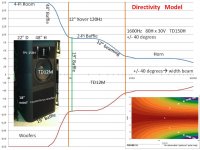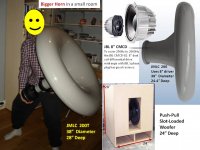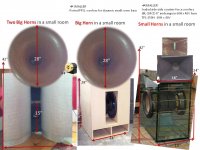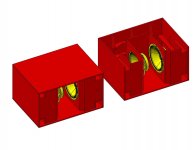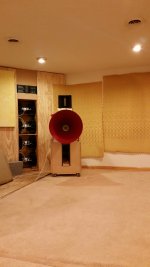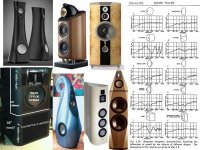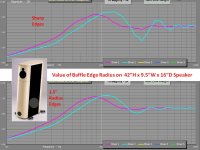I'm sure it can. Where would you choose to cross it? I'm thinking1200, maybe 800.Fyi, the SEOS24 can be used down to 380hz with the right driver.
I am at a turning point in my speaker building journey. Having recently heard the Grimm LS1's i am re-evaluating the need for mid range horns which i currently use. I have the Beyma TPL's which i like alot and am considering a sealed mid range driver to replace the midrange and midbass horns, allowing me to drop one way out my rig.
Hi Vinylnvalves,
Interesting you mention the Grimm, they (Hypex and friends) have just upgraded their whole ethos and launched a £10K end game solution....It looks cool!
acoustics
Anyway, you mentioned you would like to test a BMR.....Hello!
How about I bring down some gear (mine is more portable than yours!) and we try a a mix ' match shoot out of different system dynamics / detail / size and cost?
I am a fan of the Beyma TPL / 12P80 combo....That really works well.
For domestic use my silk BMR's have all the top end sparkle and detail most folks need.
For Pro studio monitors I might offer a TPL to extend the paper frequency response out past 20K as the engineers are very keen to see that paperwork!
It will be fascinating to hear how a small array (6 or 9 BMR's) compares to big horns and CD's....?
PM me if you want to have a geek out comparison day!
All the best
Derek.
I am a fan of the Beyma TPL / 12P80 combo....That really works well.
Hello Derek. I've seen you say this before, and also speak highly about TPL + 6" or 8" PHL midranges. I've been paying attention, and I would love to get your view about options I'm considering for an active 4-way with a TPL-150H on top and a pair of subs below 80Hz:
- TPL + 8" PHL midrange + 12P80Nd, all in sealed enclosures. The 8" midrange would have a directivity closer to the 150H around 1800-2000Hz, and I would likely drive the 12P80Nd up to 600Hz or so.
- TPL + 12P80Nd + 12LX60V2, all in sealed enclosures. The larger midrange would provide stronger dynamics (my guess), but would likely need to xo to the TPL at 1600/1700Hz. The 12LX60V2 would probably then run from 60/70 to 300Hz, but it's much slower driver than 12P80Nd (Mms/Bl).
- TPL + 8" PHL + 12LX60V2.
- Forget about 4-way, simplify and do a 3-way with TPL + 12P80Nd + subs.
Very interested in your view, especially about 1) and 2).
Cheers!
3 way, Smaart software & your done!
Hi Lewinski,
Go three way and you will save a lot of time, money and space and have 80% to 90% of the sound quality of the 4 way....Maybe even the 3 way will sound better, as its very easy to mess up a 4 way system....Unless you have a lot of experience and skills, avoid a 4 way.
A 3 way in your case is really a two way plus subs, this is easier to get right!
In my opinion go for 3 way as follows:
(1) TPL, remove back and run it in its own asymetric sealed box of approx 1 litre to 1.5 litres of air. Heavily damped internal cabinet walls plus Twaron / Angel Hair in a sealed soft cotton bag.
A lot of trial and error is involved with the fine tuning of the cabinet volume and damping of a TPL run like this, but the improvement over the standard sealed unit is major.
Cross over the TPL around 1.9KHz to 2.1KHz.
(2) Run a single 8 inch PHL fabric surround midrange in an asymetric sealed cabinet, again damping and stuffing important. Use 12 litres sealed total volume, allow of 5 litres of cabinet wall damping, air volume occupied by the driver and Twaron stuffing in cotton bag. Target is 6.8 litres of sealed air to give a Q of 0.707.
Cross it over around 250Hz to the following bass driver(s). (You could run two of these bass drivers, if you want to fill a huge room with 110dB peaks....)
(3) Beyma 15P80Fe. Run this sealed in 30 litres, allow 10 litres for damping and driver. Target is 20 litres sealed, Q of 0.707. You will need lots of clean power here....Think NCore or similar top class D. A good 800 watts to 1,000 watts is required to drive/ control the Beyma in a small box. No one else will agree with this loading....Build it and they will understand!
The above system (single 15 inch Beyma) will provide very high SPL's at very low distortion levels. Building seperate cabinets for each driver allows easy physical driver time alignment which simplifies crossover design....
The whole subject of Linear Phase crossovers and Eq is complex and one which I do not have the time to cover....Sorry!
There are loads of good PC based crossover systems and lots of guys on the forum to help you....
My best advice is seek out a Smaart Live software package :
http://www.rationalacoustics.com
buy it and then go on one of Smaarts fantastic 2 or 3 day courses to show you how to really design loudspeakers!
All the best
Derek.
PS - I am heavily involved in a commercial venture using BMR's and I dont have the time to get involved in the complex job of conventional driver systems....So I will have to bow out of this thread, but good luck whatever you decide to build!
Hi Lewinski,
Go three way and you will save a lot of time, money and space and have 80% to 90% of the sound quality of the 4 way....Maybe even the 3 way will sound better, as its very easy to mess up a 4 way system....Unless you have a lot of experience and skills, avoid a 4 way.
A 3 way in your case is really a two way plus subs, this is easier to get right!
In my opinion go for 3 way as follows:
(1) TPL, remove back and run it in its own asymetric sealed box of approx 1 litre to 1.5 litres of air. Heavily damped internal cabinet walls plus Twaron / Angel Hair in a sealed soft cotton bag.
A lot of trial and error is involved with the fine tuning of the cabinet volume and damping of a TPL run like this, but the improvement over the standard sealed unit is major.
Cross over the TPL around 1.9KHz to 2.1KHz.
(2) Run a single 8 inch PHL fabric surround midrange in an asymetric sealed cabinet, again damping and stuffing important. Use 12 litres sealed total volume, allow of 5 litres of cabinet wall damping, air volume occupied by the driver and Twaron stuffing in cotton bag. Target is 6.8 litres of sealed air to give a Q of 0.707.
Cross it over around 250Hz to the following bass driver(s). (You could run two of these bass drivers, if you want to fill a huge room with 110dB peaks....)
(3) Beyma 15P80Fe. Run this sealed in 30 litres, allow 10 litres for damping and driver. Target is 20 litres sealed, Q of 0.707. You will need lots of clean power here....Think NCore or similar top class D. A good 800 watts to 1,000 watts is required to drive/ control the Beyma in a small box. No one else will agree with this loading....Build it and they will understand!
The above system (single 15 inch Beyma) will provide very high SPL's at very low distortion levels. Building seperate cabinets for each driver allows easy physical driver time alignment which simplifies crossover design....
The whole subject of Linear Phase crossovers and Eq is complex and one which I do not have the time to cover....Sorry!
There are loads of good PC based crossover systems and lots of guys on the forum to help you....
My best advice is seek out a Smaart Live software package :
http://www.rationalacoustics.com
buy it and then go on one of Smaarts fantastic 2 or 3 day courses to show you how to really design loudspeakers!
All the best
Derek.
PS - I am heavily involved in a commercial venture using BMR's and I dont have the time to get involved in the complex job of conventional driver systems....So I will have to bow out of this thread, but good luck whatever you decide to build!
Attachments
Just had some time to ponder this counterforce sealed woofer suggested early on, i have been worried about having a pair of 18" drivers per side being a bit OTT. Was wondering if a pair of 15" drivers such as the Beyma SM-115/K would be a reasonable proposition, in the sealed cabinet. I remember hearing a pair of these maybe the k200's some time back and thinking they sounded quite nice.
115K in sealed box
I am running a SM 115K in a sealed box right now....Also running a 12 inch Beyma in a smaller sealed box on the other side.....
Great results, ask any of the guys on that have been for a visit recently....
I vary the crossover between 80Hz and 200Hz depending on what main speakers I am using, the 115K is a the best value around in my opinion.
Hope this helps and all the best
Cheers
D.
PS,
Will be visiting Mark in a couple of weeks and can make a weekend if you want to pop over there?
I am running a SM 115K in a sealed box right now....Also running a 12 inch Beyma in a smaller sealed box on the other side.....
Great results, ask any of the guys on that have been for a visit recently....
I vary the crossover between 80Hz and 200Hz depending on what main speakers I am using, the 115K is a the best value around in my opinion.
Hope this helps and all the best
Cheers
D.
PS,
Will be visiting Mark in a couple of weeks and can make a weekend if you want to pop over there?
I always thought that the deeper cone of a 12incher had a narrower dispersion and was matching that of TPL-150h at the typical Xo point much better than an 8 incher. that also seemed to be a consensus in the other thread(s) discussing the same combo.
Around the common crossover frequency range of 1600-2200Hz, the TPL-150H horn produces an 80 degree horizontal polar pattern and a 30 degree vertical polar pattern. A well designed 1600Hz Xover is considered by many as the lowest "good sounding" TPL-150H point. A well designed 2000Hz Xover is considered by many as the lowest "great sounding, no strain" TPL-150H point.
A FEW 12" midbass speakers beam into an 80 degree polar pattern around 1600Hz, and these drivers can produce a "smooth" polar function when properly crossed to the TPL-150H on a clever low diffraction baffle. SOME of these 12" midbass speakers have T/S parameters which support ~100Hz F3 bass in a tight transient sealed box. Add some high efficiency woofers and you have an excellent 3-way speaker.
A FEW 8" midbass speakers beam into an 80 degree polar pattern around 2000Hz, and these drivers can produce a "smooth" polar function when properly crossed to the TPL-150H on a clever low diffraction baffle. MOST of these 8" midbass speakers have T/S parameters which support ~250-300Hz F3 bass in a tight transient sealed box. Add some high efficiency woofers and you have a "good modest low-bass" 3-way speaker, but also add a subwoofer and you have an "exellent 20-20Khz" 4-way speaker.
Attachments
Small Room Woofer Thoughts:
---If you always plan to use a large midrange horn(28" to 30" JMLC), then push-pull slot loaded ported woofers is the best tech for a small room.
---If you plan to move to smaller midrange horns(JBL 8" CMCD in 19" PT horn) or a BMF-1 type 3-way with the TPL-150H tweeter, then equalized Side-Side counter-force sealed box woofers is the best tech for a small room.
====================
vinylnvalves: "My room is only 16 ft x 13 ft x 8ft 6."
You have a small room. Your speakers are very close to 2 walls.
Disappointing past systems:
1) 28" JMLC midhorn + Onken woofer + TPL-150H tweeter
2) 28" JMLC midhorn + 414Z MLTL@35Hz + TPL-150H tweeter
3) 28" JMLC midhorn + Dual 15" horn_dipole woofers + TPL-150H tweeter
Remaining good woofer ideas....
4) Push-pull, front slot-loaded, ported woofers.
++Slot generates Good Dynamics
++Performs well with passive Xover. Direct connect Tube amp friendly.
---Larger than two sealed woofs.
5) Side-Side counter-force sealed woofers.
---Active Equalization required.
++good SPL/box_volume with active equalization.
++Allows flexible Qtc and complex DSP room equalization
++High Efficiency. Tube amp after equalizer.
---If you always plan to use a large midrange horn(28" to 30" JMLC), then push-pull slot loaded ported woofers is the best tech for a small room.
---If you plan to move to smaller midrange horns(JBL 8" CMCD in 19" PT horn) or a BMF-1 type 3-way with the TPL-150H tweeter, then equalized Side-Side counter-force sealed box woofers is the best tech for a small room.
====================
vinylnvalves: "My room is only 16 ft x 13 ft x 8ft 6."
You have a small room. Your speakers are very close to 2 walls.
Disappointing past systems:
1) 28" JMLC midhorn + Onken woofer + TPL-150H tweeter
2) 28" JMLC midhorn + 414Z MLTL@35Hz + TPL-150H tweeter
3) 28" JMLC midhorn + Dual 15" horn_dipole woofers + TPL-150H tweeter
Remaining good woofer ideas....
4) Push-pull, front slot-loaded, ported woofers.
++Slot generates Good Dynamics
++Performs well with passive Xover. Direct connect Tube amp friendly.
---Larger than two sealed woofs.
5) Side-Side counter-force sealed woofers.
---Active Equalization required.
++good SPL/box_volume with active equalization.
++Allows flexible Qtc and complex DSP room equalization
++High Efficiency. Tube amp after equalizer.
Attachments
Looks as if the counter force sealed woofer's have the most going for them. I have simmed the faitals and all pair of beyma sm115k's little more natural extension from the 18" as they have a higher qts. You haven't mentioned a ppsl sealed arrangement, could the bottom end be argumented with a dsp? Would this not be the best of option 4 and 5?
Sent from my Galaxy Nexus using Tapatalk
Sent from my Galaxy Nexus using Tapatalk
low diffraction baffle ?
Please,
What exactly do you mean by a "low diffraction baffle ?
Around the common crossover frequency range of 1600-2200Hz, the TPL-150H horn produces an 80 degree horizontal polar pattern and a 30 degree vertical polar pattern. A well designed 1600Hz Xover is considered by many as the lowest "good sounding" TPL-150H point. A well designed 2000Hz Xover is considered by many as the lowest "great sounding, no strain" TPL-150H point.
A FEW 12" midbass speakers beam into an 80 degree polar pattern around 1600Hz, and these drivers can produce a "smooth" polar function when properly crossed to the TPL-150H on a clever low diffraction baffle. SOME of these 12" midbass speakers have T/S parameters which support ~100Hz F3 bass in a tight transient sealed box. Add some high efficiency woofers and you have an excellent 3-way speaker.
A FEW 8" midbass speakers beam into an 80 degree polar pattern around 2000Hz, and these drivers can produce a "smooth" polar function when properly crossed to the TPL-150H on a clever low diffraction baffle. MOST of these 8" midbass speakers have T/S parameters which support ~250-300Hz F3 bass in a tight transient sealed box. Add some high efficiency woofers and you have a "good modest low-bass" 3-way speaker, but also add a subwoofer and you have an "excellent 20-20Khz" 4-way speaker.
Please,
What exactly do you mean by a "low diffraction baffle ?
You haven't mentioned a ppsl sealed arrangement, could the bottom end be argumented with a dsp? Would this not be the best of option 4 and 5?
Your speakers require a woofer that covers 20Hz - 250Hz, and blends well with a big midrange horn, in a small room, when placed near two walls.
Push-Pull slot-loaded woofers generate a high impact bass wave launch with a focused air pressure energy that travels several feet before diffusing. In a small room the slot is aimed at the listener in an effort to increase the perceived dynamic impact. A very good match for a horn midrange. At low SPL levels, the slot's focused energy wave is linear over the operating frequency range. At high SPL levels, the high air pressures between the two drivers in the narrow slot can affect the perceived T/S parameters and create a non-linear response.
With sealed woofers, one narrow single push-pull slot must deliver high-equalized low(20-50Hz) bass in addition to voice-critical 150-250Hz. Slot loaded 20-250Hz (with high efficiency+bandwidth woofers) creates baddd audio JuJu. A narrow slot is required to avoid resonances anywhere near 250Hz, BUT a wide slot is required to avoid T/S parameter shifts from high air pressure 20-50Hz low bass. Baddd audio JuJu.
--The low bass air pressure in the narrow slot affects the (high efficiency+bandwidth) sealed woofer's perceived T/S parmeters, and this modulates the ear sensitive midbass.
--The low bass air pressure in the narrow slot competes with high-impact percussion impulses.
--Increasing the slot volume to accomodate the low bass pressures starts to reduce the directional high-impact percussion impulses.
Moving the low bass energy out of the shared narrow slot into ports is my JuJu charm.
Attachments
I wondered the same.Please,
What exactly do you mean by a "low diffraction baffle ?
Linesource, what do you think of vinylnvalve's non standard tweeter waveguide, and wouldn't a vertically stacked pair of mids match (at least the standard) TPL better?
Your speakers require a woofer that covers 20Hz - 250Hz, and blends well with a big midrange horn, in a small room, when placed near two walls.
Push-Pull slot-loaded woofers generate a high impact bass wave launch with a focused air pressure energy that travels several feet before diffusing. In a small room the slot is aimed at the listener in an effort to increase the perceived dynamic impact. A very good match for a horn midrange. At low SPL levels, the slot's focused energy wave is linear over the operating frequency range. At high SPL levels, the high air pressures between the two drivers in the narrow slot can affect the perceived T/S parameters and create a non-linear response.
With sealed woofers, one narrow single push-pull slot must deliver high-equalized low(20-50Hz) bass in addition to voice-critical 150-250Hz. Slot loaded 20-250Hz (with high efficiency+bandwidth woofers) creates baddd audio JuJu. A narrow slot is required to avoid resonances anywhere near 250Hz, BUT a wide slot is required to avoid T/S parameter shifts from high air pressure 20-50Hz low bass. Baddd audio JuJu.
--The low bass air pressure in the narrow slot affects the (high efficiency+bandwidth) sealed woofer's perceived T/S parmeters, and this modulates the ear sensitive midbass.
--The low bass air pressure in the narrow slot competes with high-impact percussion impulses.
--Increasing the slot volume to accomodate the low bass pressures starts to reduce the directional high-impact percussion impulses.
Moving the low bass energy out of the shared narrow slot into ports is my JuJu charm.
You have just described my operating system
(view of the left channel; I sit 13 feet away.
Attachments
For info - The non standard wave gude for the TPL has the same exit angles and expansion as the OEM wave guide ( i copied one) it just has a bigger mouth and also a rolled edge which terminates normal to the driver (90degs) so it could be integrated into a baffle.
I would like to understand what a low diffraction baffle is as well.
For The PPSL - will it extend as far as 350 Hz? As thats as low as i like running the midrange horns (phase changes below that)
Any recommendations for drivers for the PPSL in europe. I have seen on the forum the Dayton 15" seem to be popular. I however feel i would like to stay with a light cone and big motor. Are the Beyma sm115K's suitable for this application?
Bit of a curve ball thought,I think i understand the PPSL and unsetting the JuJu!!!. However if say you only wanted the PPSL to work upto say 80Hz, so go under a sealed midrange would it work in a sealed configuration as a sub.
BTW - i have borrowed a pair of 15" deltalites which i will tryout in my OB bass horns to see if the limited xmax is the reason for them not living up to expectation.
I would like to understand what a low diffraction baffle is as well.
For The PPSL - will it extend as far as 350 Hz? As thats as low as i like running the midrange horns (phase changes below that)
Any recommendations for drivers for the PPSL in europe. I have seen on the forum the Dayton 15" seem to be popular. I however feel i would like to stay with a light cone and big motor. Are the Beyma sm115K's suitable for this application?
Bit of a curve ball thought,I think i understand the PPSL and unsetting the JuJu!!!. However if say you only wanted the PPSL to work upto say 80Hz, so go under a sealed midrange would it work in a sealed configuration as a sub.
BTW - i have borrowed a pair of 15" deltalites which i will tryout in my OB bass horns to see if the limited xmax is the reason for them not living up to expectation.
low diffraction baffle
BTW - i have borrowed a pair of 15" deltalites which i will tryout in my OB bass horns to see if the limited xmax is the reason for them not living up to expectation.
As early as 1951 researchers like Harry Olson published experimental measurements on cabinet shape vs. diffraction, so there is a great deal of tech literature on the topic.
In the Big Horn world, the LeCleach large radius mouth provides low diffraction. There is now an extended Tractrix that includes a large radius mouth roll-over.
I use a 1.5" radius round-over bit with my router table for narrow box edges, and use a friend's cabinet shop shaper for 3" - 4" radius for wide box edges.
Today's better speakers:
--Drivers get flush counter-sink into the baffle. All
--Cabinet edges get round-overs with a radius of 1.5" or greater. Gary Dahl 6" radius Altec Midbass
--Sliding-angle chamfer edge cuts used to spread diffraction and control polar response. Avalon
--Sphere + tapered tube = low diffraction and reduced resonances. B&W
--Tweeter location offset on baffle to spread diffraction over wider frequency range. Many
--Large mouth radius horns. LeCleach
=========
I would expect 15" Deltalites will make a large difference in clean bass output. I am very interrested in your listening impressions. Have you sim'ed a sealed back design with your bass horns? They are so close to walls that dipole cancellation may not form.
======
PPSL.... A sealed subwoofer pair up to 80Hz should work well if you select ROBUST subwoofer drivers. Expect "modest" efficiency. A quick sim of the required slot volume also seems necessary. One alternative is to put two single subwoofers around your walls to reduce room bass modes at the listening area.
PPSL.... I do not have any knowledge to help with a 350Hz PPSL design.
Attachments
Scott - any further info on your PPSL bass, it looks like you would be crossing around 200Hz with that horn. The big question is this about the limit for PPSL's? Quickly looking around the PPSL thread - i don't think even with a clever plenum chamber i will get a response upto 350Hz.
Starting to think that it is going to be a sealed EQ sub and a sealed mid, thats the safe bet
Won't be trying the deltalites in the OB horns as they are so physically different to the existing drivers i would have to build a whole new back frame, shame.
Starting to think that it is going to be a sealed EQ sub and a sealed mid, thats the safe bet
Won't be trying the deltalites in the OB horns as they are so physically different to the existing drivers i would have to build a whole new back frame, shame.
measurements
To answer the first question, I cross at 250Hz, 18db/oct.
As to the frequency performance of these ppsl's I have also wondered that, for a long time. Today, I measured. Using Stereophile's TEST CD#2, tracks 16 & 17. These are 1/3 octave warble tones.
These are the results, using a Radio Shack SPL meter, and adding in any corrrections IF more than .5 db
BASS DECADE; 200-97, 160-104, 125-105, 100-105, 80-102.5, 63-100.5,
50-96.5, 40-94, 31.5-89, 25-88, 20-84
MIDRANGE DECADE; 250-97, 315-101.5, 400-102, 500-99, 630-95, 800-92,
1.0K-93, 1.25K-91.5, 1.6K-88, 2.0K-91
I placed the SPL meter about 1 inch away from the slot. Sorry, but I don't have an exact power level, but guessing around 1 watt. I was surprised the response went as high as it did. This test was without any active crossover, straight into the power amp. I guess I have a "suck-out" in the 200-250Hz area.
Here's my personal take on this ppsl unit. It's strengths are in the dynamic impact area; the bass "hits" are very quick and tight; effortless, if you will.
On the Sheffield Drum and Track disc, Jim Keltner's Drum solo is mighty impressive, and when there's quick double bass hits, I can hear each as distinct notes, whereas on other systems they sound like mud. However, on other conventional front firing direct radiators, I hear an immediacy quality that I just don't seem to have. It might be the "suck-out" (?) My overall general feelings are this type of unit is best served for the lower frequencies, even though the response does not seem very restricted up until about 500Hz, and even then, it's a shallow roll-off above. My future plans are to restrict the range to under about 150Hz, and use a direct radiator to meet a new mid range system, as I am deleting the big red horns to allow for a greater number of listeners to enjoy the music.
Other builders may have different results that what I have discovered. The drivers are Eminence Definimax 4012HO. The slot is truncated towards the rear, ending in a 4 inch plate, loaded with acoustic. The parallel slot walls are
five inches wide.
Scott - any further info on your PPSL bass, it looks like you would be crossing around 200Hz with that horn. The big question is this about the limit for PPSL's? Quickly looking around the PPSL thread - i don't think even with a clever plenum chamber i will get a response upto 350Hz.
Starting to think that it is going to be a sealed EQ sub and a sealed mid, thats the safe bet
Won't be trying the deltalites in the OB horns as they are so physically different to the existing drivers i would have to build a whole new back frame, shame.
To answer the first question, I cross at 250Hz, 18db/oct.
As to the frequency performance of these ppsl's I have also wondered that, for a long time. Today, I measured. Using Stereophile's TEST CD#2, tracks 16 & 17. These are 1/3 octave warble tones.
These are the results, using a Radio Shack SPL meter, and adding in any corrrections IF more than .5 db
BASS DECADE; 200-97, 160-104, 125-105, 100-105, 80-102.5, 63-100.5,
50-96.5, 40-94, 31.5-89, 25-88, 20-84
MIDRANGE DECADE; 250-97, 315-101.5, 400-102, 500-99, 630-95, 800-92,
1.0K-93, 1.25K-91.5, 1.6K-88, 2.0K-91
I placed the SPL meter about 1 inch away from the slot. Sorry, but I don't have an exact power level, but guessing around 1 watt. I was surprised the response went as high as it did. This test was without any active crossover, straight into the power amp. I guess I have a "suck-out" in the 200-250Hz area.
Here's my personal take on this ppsl unit. It's strengths are in the dynamic impact area; the bass "hits" are very quick and tight; effortless, if you will.
On the Sheffield Drum and Track disc, Jim Keltner's Drum solo is mighty impressive, and when there's quick double bass hits, I can hear each as distinct notes, whereas on other systems they sound like mud. However, on other conventional front firing direct radiators, I hear an immediacy quality that I just don't seem to have. It might be the "suck-out" (?) My overall general feelings are this type of unit is best served for the lower frequencies, even though the response does not seem very restricted up until about 500Hz, and even then, it's a shallow roll-off above. My future plans are to restrict the range to under about 150Hz, and use a direct radiator to meet a new mid range system, as I am deleting the big red horns to allow for a greater number of listeners to enjoy the music.
Other builders may have different results that what I have discovered. The drivers are Eminence Definimax 4012HO. The slot is truncated towards the rear, ending in a 4 inch plate, loaded with acoustic. The parallel slot walls are
five inches wide.
Have you considered that maybe a pair of 8", maybe 10" in am MTM might match directivity of the TPL at a sub 2000Hz crossover? They should then match a 180 degree bass presentation a couple of octaves below if you size the baffle appropriately. (and radius it).considering a sealed mid range driver to replace the midrange and midbass horns, allowing me to drop one way out my rig.
Have you considered that maybe a pair of 8", maybe 10" in am MTM might match directivity of the TPL at a sub 2000Hz crossover? They should then match a 180 degree bass presentation a couple of octaves below if you size the baffle appropriately. (and radius it).
A pretty good idea. I've often wondered the same, using something like this,
above and below the TPL:
http://www.faitalpro.com/products/files/10PR300/8/10PR300_datasheet_8.pdf
- Status
- This old topic is closed. If you want to reopen this topic, contact a moderator using the "Report Post" button.
- Home
- Loudspeakers
- Multi-Way
- Advise on mid range driver
